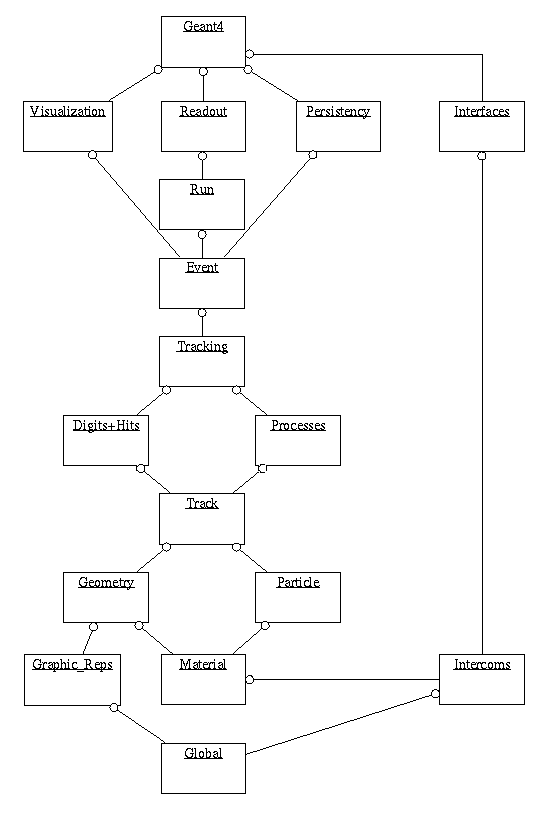|
|
Geant4 User's Documents |
At the heart of Geant4 is an abundant set of physics models to handle the interactions of particles with matter across a very wide energy range. Data and expertise have been drawn from many sources around the world and in this respect, Geant4 acts as a repository which incorporates a large part of all that is known about particle interactions.
Geant4 is written in C++ and exploits advanced software-engineering techniques and object-oriented technology to achieve transparency. For example, the way in which cross sections are input or computed is separated from the way in which they are used or accessed. The user can overload both of these features. Similarly, the computation of the final state can be divided into alternative or complementary models, according to the energy range, the particle type, and the material. To build a specific application the user-physicist chooses from among these options and implements code in user action classes supplied by the toolkit. A serious problem with previous simulation codes was the difficulty of adding new or variant physics models; development was difficult due to the increased size, complexity and interdependency of the procedure-based code. In contrast, object-oriented methods help manage complexity and limit dependencies by defining a uniform interface and common organizational principles for all physics models. Within this framework the functionality of models can be more easily recognized and understood, and the creation and addition of new models is a well-defined procedure that entails little or no modification to the existing code.
The RD44 project represented a pioneering effort in redesigning a major CERN software package for a modern object-oriented (OO) environment based on C++. The R&D phase was completed in December 1998 with the delivery of the first production release. The collaboration was subsequently renamed Geant4 and reinstated on the basis of a formal Memorandum of Understanding (MoU) signed by many of the same national institutes, laboratories and large HEP experiments who participated in RD44. The agreement addresses the program management, maintenance and user support during the production phase and the continued development and refinement of the toolkit. It is subject to tacit renewal every two years and sets out a collaboration structure defined by a Collaboration Board (CB), a Technical Steering Board (TSB) and several working groups.
The collaboration now profits from the accumulated experience of many contributors to the field of Monte Carlo simulation of physics detectors and physical processes. While geographically distributed software development and large-scale object-oriented systems are no longer a novelty, Geant4, in terms of the size and scope of the code and the number of contributors, may well represent the largest and most ambitious project of its kind outside the corporate world. A clean overall problem decomposition has led to a clear hierarchical structure of domains. Every section of the Geant4 software, which corresponds to a releasable component (library), is individually managed by a working group of experts. In addition, there is a working group for each of the activities: testing and quality assurance, software management and documentation management. A release coordinator heads each group. This consequent distribution of responsibility among a relative large number of people permits a support structure whereby outside users can address questions directly to the appropriate expert.
Categories at the bottom of the diagram are used by virtually all higher categories and provide the foundation of the toolkit.
TheThe two categories:
The

|
| Fig. 1 Geant4 class categories |
Above these reside categories required to describe the tracking of particles and the physical processes they undergo. The
All processes are invoked by the
Above these the
Finally capabilities that use all of these categories and connect to
facilities outside the toolkit through abstract interfaces, provide
visualization, persistency and user interface
capabilities.
New requirements, such as requests for new functionality, are presented to and decided by the Technical Steering Board (TSB). The TSB sets the priorities and agrees on time-scales for the fulfillment of new requirements. Such support is guaranteed to collaboration members, while requests from non-members are handled on a best effort basis.
For each member organisation a contact person (TSB member) has been designated who acts as a first reference for Geant4 users in that locality, which may include affiliated institutions, user groups, and others in the same geographic area. The contact person will respond to enquiries, help resolve simple problems, and forward more specialized queries to the relevant expert(s).
Beyond that, a list of frequently asked questions
(FAQs), and an internet-based
user forum complete the available Geant4 user support.
The application programmer is central to any simulation task. A firm knowledge of C++ is required to implement code in user action classes to specify, at a minimum, the detector description, the relevant particles and physics processes, and the initial event kinematics. A manual for the application programmer is found in the User's Guide: For Application Developers.
Using standard components of Geant4, a framework provider would add interfaces to external tools, such as for example, to Computer Aided Design (CAD) programs, Object-Oriented Data Base Management Systems (ODBMS) and graphics systems. This requires the development of new classes overloading standard Geant4 functionality and hence a solid understanding of object-oriented Programming. A manual for the framework provider is found in the User's Guide: For Toolkit Developers.
References
All user documentation can be found on the Geant4 homepage http://cern.ch/geant4.
References for Object-Oriented Technology: